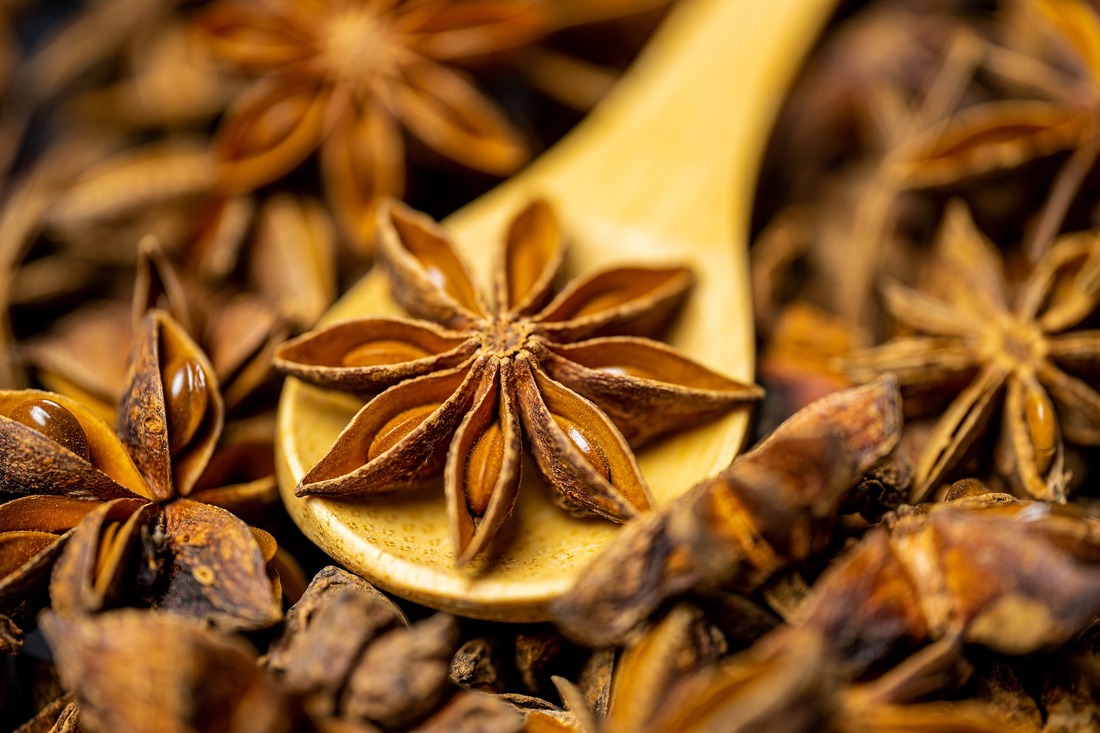HEALTH
Uncovering the Wonders of Star Anise: Health Benefits, Culinary Uses, and More

Star anise is an aromatic spice that has captivated the culinary world with its distinct flavor and star-shaped appearance. Originating from Southeast Asia, particularly from regions in China and Vietnam, this spice has found its way into various global cuisines, traditional medicines, and even the world of essential oils. Its scientific name, Illicium verum, reflects its long-standing significance in various cultures, where it is revered not just for its culinary applications but also for its medicinal properties.
Star anise is not just a feast for the taste buds; it is also a sight to behold. The spice is recognized by its eight-pointed star-shaped pods, each containing a seed. These pods are harvested before ripening and then sun-dried to bring out the rich, warm, and sweet licorice-like flavor that star anise is famous for. This unique taste profile makes it a popular choice in both sweet and savory dishes, as well as in beverages like teas and mulled wines.
In addition to its culinary uses, star anise has been utilized for centuries in traditional medicine. Its essential oil, derived from the seeds, is known for its powerful therapeutic properties, including antimicrobial, antifungal, and antioxidant effects. As we delve deeper into the world of star anise, we will explore its health benefits, culinary versatility, and much more.
Nutritional Profile of Star Anise
Understanding the nutritional profile of star anise sheds light on why this spice is more than just a flavoring agent. Star anise is a good source of several essential nutrients, including vitamins A and C, calcium, and iron. These nutrients contribute to its health-promoting properties, making it a valuable addition to a balanced diet.
One of the key components of star anise is shikimic acid, a compound with significant antiviral properties. Shikimic acid is a precursor for the synthesis of oseltamivir, an active ingredient in the antiviral medication Tamiflu. This highlights star anise’s potential to support immune health, especially during flu season.
Moreover, star anise contains various bioactive compounds such as flavonoids, polyphenols, and terpenes. These compounds are known for their antioxidant properties, helping to combat oxidative stress and reduce inflammation in the body. The presence of anethole, the compound responsible for its licorice-like flavor, also contributes to its health benefits, particularly in supporting digestive health.
Health Benefits of Star Anise
The health benefits of star anise are both diverse and impressive, making it a popular choice in natural remedies. Its rich composition of bioactive compounds contributes to various therapeutic effects, which have been recognized in traditional medicine for centuries.
Boosting Immunity with Star Anise
One of the most well-known health benefits of star anise is its ability to boost the immune system. Thanks to its high concentration of shikimic acid, star anise plays a crucial role in enhancing the body’s natural defense mechanisms. Shikimic acid has been widely studied for its antiviral properties, particularly in the prevention and treatment of influenza. Incorporating star anise into your diet, especially during the cold and flu season, can provide a natural boost to your immune health.
Antimicrobial and Antifungal Properties
Star anise’s antimicrobial and antifungal properties make it a powerful natural remedy for fighting infections. Studies have shown that star anise essential oil exhibits strong activity against various bacteria and fungi, including strains that are resistant to conventional antibiotics. This makes star anise a valuable component in alternative medicine, where it is used to treat a range of infections, from respiratory to gastrointestinal.
Promoting Digestive Health
For centuries, star anise has been used to support digestive health. Its carminative properties help alleviate symptoms of indigestion, bloating, and gas. The anethole compound found in star anise promotes the secretion of digestive enzymes, facilitating smoother digestion and reducing discomfort. Additionally, star anise can be used to treat colic in infants, making it a gentle yet effective remedy for digestive issues in both adults and children.
Antioxidant Powerhouse: Fighting Free Radicals
The antioxidant properties of star anise are another reason why it is celebrated in traditional medicine. Antioxidants are crucial for neutralizing free radicals in the body, which can cause cellular damage and contribute to chronic diseases such as cancer and heart disease. The polyphenols and flavonoids in star anise help protect the body’s cells from oxidative stress, reducing the risk of disease and promoting overall health.
Managing Respiratory Conditions with Star Anise
Respiratory conditions, such as coughs, colds, and bronchitis, can be effectively managed with star anise. The spice acts as a natural expectorant, helping to loosen mucus and phlegm, making it easier to expel from the respiratory tract. This is particularly beneficial in treating symptoms of respiratory infections and asthma. Star anise tea, prepared by steeping the pods in hot water, is a soothing remedy for respiratory discomfort, providing relief from congestion and coughs.
Culinary Uses of Star Anise
Star anise’s distinct flavor profile has made it a staple in various culinary traditions around the world. Its sweet, licorice-like taste pairs well with a wide range of dishes, from savory meats to sweet desserts, making it a versatile spice in the kitchen.
Enhancing Flavor in Global Cuisines
In global cuisines, star anise is often used as a flavor enhancer, adding depth and complexity to dishes. In Chinese cuisine, star anise is a key ingredient in the famous five-spice powder, which is used to season meats, soups, and stir-fries. The spice is also popular in Indian and Middle Eastern cooking, where it is used in spice blends like garam masala and biryani. Its unique flavor profile complements rich, hearty dishes, adding a subtle sweetness that balances the spices.
Star Anise in Asian Cuisine: A Staple Spice
In Asian cuisine, particularly in Chinese and Vietnamese dishes, star anise is a staple spice. It is commonly used in slow-cooked dishes, such as braised meats and stews, where it infuses the food with its aromatic flavor. In Vietnamese pho, a traditional noodle soup, star anise is an essential component of the broth, contributing to its distinctive taste. The spice is also used in making soy sauce, enhancing its flavor and aroma.
Baking with Star Anise: Sweet and Savory Delights
Baking with star anise opens up a world of sweet and savory delights. The spice adds a unique flavor to baked goods, from cookies and cakes to breads and pastries. Its warm, sweet taste pairs well with fruits like apples and pears, making it a popular addition to pies and tarts. In savory baking, star anise can be used in bread recipes, adding an aromatic twist.

-

 BUSINESS3 months ago
BUSINESS3 months agoGrow Your Audience with USA Instagram Followers
-

 TECH3 months ago
TECH3 months agoFreedom Forever Solar Reviews Explain How Conversational Intelligence Turns Customer Interactions into Insights
-

 HEALTH3 months ago
HEALTH3 months agoExploring the Best Cannabis Product Options for Every Lifestyle
-

 BUSINESS3 months ago
BUSINESS3 months agoOn the Frontlines of Conservation: The Role of Tracker Academy Graduates in Anti-Poaching